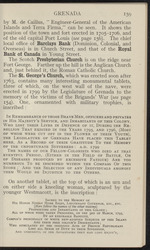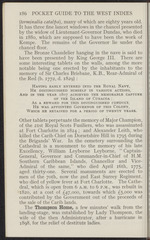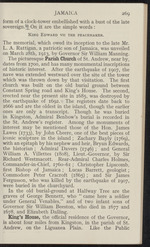| 1 |
 |
“...of the old capital Port Louis (see page 156). The chief
local office of Barclays Bank (Dominion, Colonial, and
Overseas) is in Church Street, and that of the Royal
Bank of Canada in Young Street.
The Scotch Presbyterian Church is on the ridge near
Fort George. Farther up the hill is'the Anglican Church
and, just behind it, the Roman Catholic Church.
The St. George’s Church, which was erected soon after
1763, contains many interesting monumental tablets,
three of which, on the west wall of the nave, were
erected in 1799 by the Legislature of Grenada to the
memory of the victims of the Brigands’ War (see page
154). One, ornamented with military trophies, is
inscribed:
In Remembrance of those Brave Men, officers and privates
in His Majesty’s Service, and Inhabitants of this Colony,
Who lost their Lives in Defence of it, During the Re-
bellion That existed in the Years 1795, and 1796, (Most
OF WHOM WERE CUT OFF IN THE FLOWER OF THEIR YOUTH),
the Legislature of Grenada Have placed this Tablet...”
|
|
| 2 |
 |
“...i86 POCKET GUIDE TO THE WEST INDIES
(terminalia catalpa), many of which are eighty years old.
It has three fine lancet windows in the chancel presented
by the widow of Lieutenant-Governor Dundas, who died
in 1880, which are supposed to have been the work of
Kempe. The remains of the Governor lie under the
chancel floor.
The Bronze Chandelier hanging in the nave is said to
have been presented by King George III. There are
some interesting tablets on the walls, among the more
notable being one erected by the inhabitants to the
memory of Sir Charles Brisbane, K.B., 'Rear-Admiral of
the Red (b. 1772, d. 1829) :
Having early entered into the Royal Navy,
He distinguished himself in various actions.
And in the year 1807 achieved the memorable capture
of the Island of Curacoa :
As A reward for this distinguished conduct,
He was appointed Governor of this Colony,
Which he retained for a period of twenty years.
Other tablets perpetuate the memory of Major Champion,
of the 21st Royal Scots Fusiliers...”
|
|
| 3 |
 |
“...making
sitting room for 1,200 in all. In 1895 the Vestry was
added and the old brick wall, which formerly surrounded
the churchyard, was replaced by the present railing
The church was seriously damaged by the earthquake
of 1907, but happily the roof and floor remained intact,
and the organ (erected in 1878), the lectern (1886), bell
(1890), and pulpit (1891) were saved from the wreckage.
The church was restored on its original lines with slight
modifications—-which included an extension of the nave
by 18 feet at the western end, so that it now covers the
ground occupied by the old tower. It. was opened for
Divine Service on February 21st, 1910. The new tower
was completed in 1931.
The church had always been known as the Parish
Church, and no record exists of its ever having been
dedicated to any Saint, till on its reconsecration after
the earthquake, it was dedicated to St. Thomas.
Most treasured of all its monuments is the tombstone,
in the chancel, of Vice-Admiral John Benbow, who died...”
|
|
| 4 |
 |
“...JAMAICA 369
form of a clock-tower embellished with a bust of the late
sovereign.8! On it are the simple words :
King Edward vii the peacemaker.
The memorial, which owed its inception to the late Mr.
L. A. Rattigan, a patriotic son of Jamaica, was unveiled
on March 28th, 1913, by Governor Sir William Manning.
The picturesque Parish Church of St. Andrew, near by,
dates from 1700, and has many monumental inscriptions
of historic interest. After the earthquake of 1907, the
nave was extended westward over the site of the tower
which was thrown down by that visitation. The first
church was built on the old burial ground between
Constant Spring road and King’s House. The second,
erected near the present site in 1685, was destroyed by
the earthquake of 1692. h The registers date back to
1666 and are the oldest in the island, though the earlier
ones are only a transcript. Though he was buried
in Kingston, Admiral Benbow’s burial is recorded in
the St. Andrew’s register. Among the monuments of
interest...”
|
|
